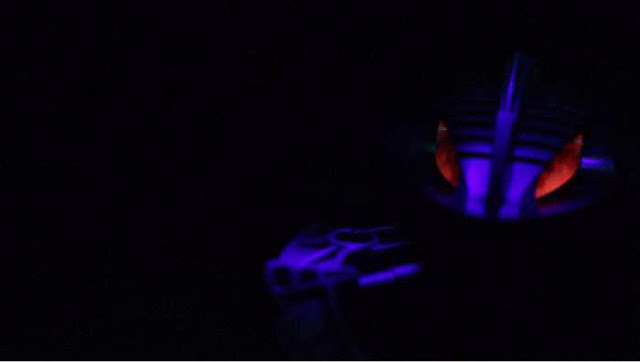At the same time, I modified another flashlight into a red spectrum night-vision-safe flashlight. Now I can see at night without blinding myself. It's great for night photography, stargazing and camping.
 |
| The UV blacklight really made the orange florescent eyes of this LEGO creation glow - and the silvery body looked pretty cool too. |
 |
| The red LEDs created a handy night-vision saving glow. You can see what you are doing, even walk around on a moonless night without blinding yourself. |
This turned out to be a very simple project, only about ten minutes of actual work per light. But it wasn't a straight path to the final product. Deciding what to make and how to do it took me a week, and filming it took a half day plus another hour after the sun set to get example shots.
I had a bunch of those pillbox style flashlights that are so popular right now. They're everywhere and you can get ones with dead batteries for a buck each. They have one big 20+ LED array of lights on the flat side and another, smaller 3-4 LED light on the skinny end. They use one button to toggle between on/off and the bright/dim settings.
These rounded box lights are super handy and I already have at least one of them at every work station, car and backpack. Then I got several more in a donation box and I started to get the itch to modify some of these excess ones into... into... well something.
My original idea was to use these new ones as light sources for my macro videos, like my teardown or jewelry-making tutorials. I hoped that I could combine several of the LED arrays into a single larger light-panel - maybe even put a dimmer circuit into the combined array to make a "real" video light.
But I noticed that each of the flashlights had a slightly different brightness level, or color (temperature) or a different coverage pattern. I thought maybe I was imagining it. But after opening a few of them I realized they were all different. They had different wiring and PCBs and different LEDs.
All that is no big deal if you're just using it for a flashlight. But using them as a video-light would create a blotchy, random light source - not what I was hoping for. I want a smooth, even and color correct light for my videos, not a random quilt of illumination.
I also realized that, even though they are blindingly bright as a flashlight, they were both too dim and too harsh for my needs. Even four of them combined didn't provide enough light to make a difference in videos except in the most close-up shots. It's astonishing how much light you need for high quality video.
With large, high quality, dimmable video lights available for less than $50 I couldn't justify making a version that wouldn't work well. If I'm serious about improving my videos I should just buy a good pre-made one and keep filming.
But I had opened all these cases and I needed to make something so I could feel better. I thought about making an IR version so I could use my phone camera as a night-vision scope. I have a few IR LEDs that I use for remote control projects. But when I tested them they were all too dim for the camera to see (unless pointed directly at the camera.) I can get the powerful illuminating versions of the IR LEDs very cheap, but I wanted to make something right now.
I do. however, have lots of red LEDs and some UV (blacklight) LEDs left over from previous projects. And I knew these LEDs were all 5v safe so they would work with the flashlight's 4.5v (with inline resister) without further modifications. I decided to replace the small 4xLED strip with my own LEDs. That way, I still had the big 20xLED white light to use as a flashlight. And the four LEDs for something else.
I cut out the existing strip of LEDs and arranged the new LEDs into a parallel circuit, then soldered them together using the long leads already on the LEDs. It's one of the simplest and oldest ways of making a circuit.
And it worked!!! In fact, it worked really well. The blacklight makes objects glow from several feet away and the red LED version is bright enough to see the ground well on a moonless night, but is dim enough not to night-blind me.
I'm very happy with the results. I have several more of these flashlights and I'm thinking of buying some of those strong IR LEDs to make a true night-vision illuminator (torch). And there is plenty of room in the case to include a small Arduino microcontroller. How about a variable speed strobe light, or maybe some RGB LEDs for making a custom light show.
I think I've found a great, inexpensive platform for experimenting with portable light sources, so stay tuned for more projects with these handy little flashlights.
As an Amazon Associate I earn from qualifying purchases.
Shop through our Amazon links to help support this site.
Shop through our Amazon links to help support this site.
Also find me on:
No comments:
Post a Comment